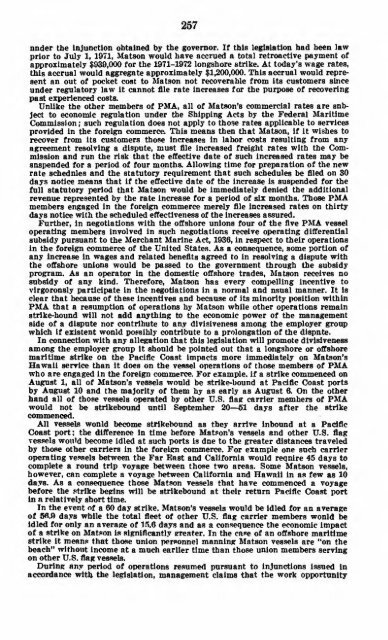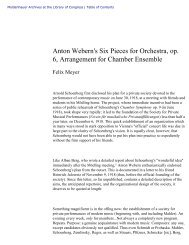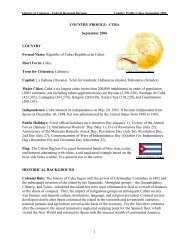1 - American Memory
1 - American Memory
1 - American Memory
Create successful ePaper yourself
Turn your PDF publications into a flip-book with our unique Google optimized e-Paper software.
257<br />
under tbe injunction obtained by tbe governor. If this legislation had been law<br />
prior to July 1, 1971, Matson would have accrued a total retroactive payment of<br />
approximately $939,000 for the 1971-1972 longshore strilce. At today's wage rates,<br />
this accrual would aggregate approximately $1,200,000. This accrual would repre-<br />
sent an out of poelcet cost to Matson not recoverable from its customers since<br />
under regulatory law it cannot file rate increases for the purpose of recovering<br />
past experienced costs.<br />
Unlilie the other members of PMA, all of Matson's commercial rates are sub-<br />
ject to economic regulation under the Shipping Acts by the Federal Maritime<br />
Commission; such regulation does not apply to those rates applicable to services<br />
provided in the foreign commerce. This means then that Matson, if it wishes to<br />
recover from its customers those increases in labor costs resulting from any<br />
agreement resolving a dispute, must file increased freight rates with the Ck>m-<br />
mission and run the rislc that the effective date of such increased rates may be<br />
suspended for a i)eriod of four months. Allowing time for preparation of the new<br />
rate schedules and the statutory requirement that such schedules be filed on 30<br />
days notice means that if the effective date of the increase is suspended for the<br />
full statutory period that Matson would be immediately denied the additional<br />
revenue represented by the rate increase for a period of six months. Those PMA<br />
members engaged in the foreign commerce merely file increased rates on thirty<br />
days notice with the scheduled effectiveness of the increases assured.<br />
Further, in negotiations with the offshore unions four of the five PMA vessel<br />
operating members involved in such negotiations receive operating differential<br />
subsidy pursuant to the Merchant Marine Act, 1936, in respect to their operations<br />
in the foreign commerce of the United States. As a consequence, some portion of<br />
any increase in wages and related benefits agreed to in resolving a dispute with<br />
the offshore unions would be passed to the government through the subsidy<br />
program. As an operator in the domestic offshore trades, Matson receives no<br />
subsidy of any Iiind. Therefore, Matson has every compelling incentive to<br />
vlrgorously participate In the negotiations in a normal and usual manner. It is<br />
clear that because of these incentives and because of its minority position within<br />
PMA that a resumption of operations by Matson while other operations remain<br />
strike-bound will not add anything to the economic power of the management<br />
side of a dispute nor contribute to any divisiveness among the employer group<br />
which if existent would possibly contribute to a prolongation of the dispute.<br />
In connection with any allegation that this legislation will promote divisiveness<br />
among the employer group it should be pointed out that a longshore or offshore<br />
maridme strike on the Pacific Coast impacts more immediately on Matson's<br />
Hawaii service than it does on the vessel operations of those members of PMA<br />
who are engaged in the foreign commerce. For example, if a strike commenced on<br />
August 1, all of Matson's ves.sels would be strike-bound at Pacific Coast ports<br />
by August 10 and the majority of them by as early as August 6. On the other<br />
hand all of those vessels operated by other U.S. flag carrier members of PMA<br />
would not be strikebound until September 20—61 days after the strike<br />
commenced.<br />
All ves-sels would become strikebound as they arrive inbound at a Pacific<br />
Coast port; the difference In time before Matson's vessels and other U.S. flag<br />
vessels would become idled at such ports is due to the greater distances traveled<br />
by those other carriers in the foreign commerce. For example one such carrier<br />
operating vessels between the Far East and California would require 45 days to<br />
complete a round trip voyage between those two areas. Some Matson vessels,<br />
however, can complete a voyage between California and Hawaii in as few as 10<br />
days. As a consequence those Matson vessels that have commenced a voyage<br />
before the .strike begins will be strikebound at their return Pacific Coast port<br />
in a relatively short time.<br />
In the event of a 60 day strike. Matson's vessels would be idled for an average<br />
of W.ft days while the total fleet of other U.S. flag carrier members would be<br />
idled for only an average of 1.5.6 days and as a consequence the economic impact<br />
of a strike on Matson is significantly ereater. In the case of an offshore maritime<br />
strike it means that those union personnel manning Matson vessels are "on the<br />
beach" without income at a much earlier time than those union members serving<br />
on other U.S. flag ves-tels.<br />
During any period of operations resumed pursuant to injunctions issued in<br />
accordance with the legislation, management claims that the work opportunity



![Albert Einstein Papers [finding aid]. Library of Congress. [PDF ...](https://img.yumpu.com/21604228/1/190x245/albert-einstein-papers-finding-aid-library-of-congress-pdf-.jpg?quality=85)





![American Colony in Jerusalem Collection [finding aid]. Library of ...](https://img.yumpu.com/17941275/1/190x245/american-colony-in-jerusalem-collection-finding-aid-library-of-.jpg?quality=85)



![Piccard Family Papers [finding aid]. - American Memory - Library of ...](https://img.yumpu.com/17941234/1/190x245/piccard-family-papers-finding-aid-american-memory-library-of-.jpg?quality=85)


